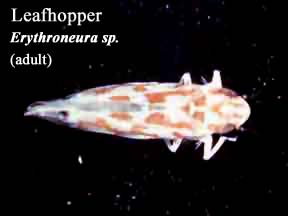Virginia-creeper (Parthenocissus)
Plant Health Problems
This host is relatively problem-free and has no serious disease problems in Connecticut.
Insect Problems:
Eightspotted forester, Alypia octomaculata.
Caterpillars cross-banded with black, white, and orange feed upon the foliage of Virginia creeper, sometimes stripping the vines. The adult is a black moth with wingspread of from 1 1/4 to 1 1/2", with two pale yellow spots on each forewing and two white spots on each rear wing. The insect winters as a pupa in the soil, and there is only one generation each year in Connecticut. Handpicking is the only control needed, except occasionally when the insect is very abundant, in which case a spray of Bacillus thuringiensis var. aizawai will prove effective. This material is registered for control of this pest in Connecticut; consult the label for dosage rates, and safety precautions.
 Leafhoppers, Erythroneura vulnerata.
Leafhoppers, Erythroneura vulnerata.
This and probably other species infest the leaves of Virginia creeper. Control measures are needed only when leafhoppers are abundant. Insecticidal soap is among the compounds registered for control of this pest in Connecticut. Soap spray needs to be directed against the undersides of the leaves. Imidacloprid may also be applied to as a systemic to be taken up by the roots; this can provide season-long control. Do not apply carbaryl to Virginia creeper, as it will damage this plant.
Sphinx caterpillars.
See Grape.
Woodbine vein gall, Dasyneura parthenocissi.
This gall is somewhat irregular in shape and occurs on the underside of the leaf along the midvein. Control measures are usually unnecessary.

